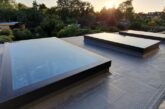
Professional Builder visits a company which has a clear vision on helping contractors choose the right glazing option.
As the second most bombed city outside of London, by the end of World War II large areas of Liverpool had been reduced to piles of rubble and broken glass. However, for one enterprising young entrepreneur called James Price, it represented a window of opportunity as he quickly established a small glazing business to restore some much needed light back into the lives of his fellow Liverpudlians.
Fast forward more than eighty years and that small corner shop bearing the TuffX name is still very much a ‘glass’ act with third generation grandson, Graham now heading up operations from an impressive manufacturing facility on the outskirts of Knowsley, north Merseyside.
“My grandad would obviously be really impressed at just how far the company has come in terms of financial growth and expansion, with more than 180 employees,” explains Graham, “but probably even more amazed at the myriad ways in which the glass itself has evolved. In his day it was more about having something simple and convenient to fill a gap, and let a bit of light in, but the range of glass products available to builders and architects today is mind blowing, including self-cleaning, fire rated, sound deadening, thermally insulating – even heated. And there are many more exciting developments to come over the next few years.”
One of the most significant breakthroughs for TuffX came in the late nineties, when new legislation made safety glass mandatory for all replacement and new projects. With familiar foresight the company had already anticipated the changes, and responded to the new demands, by investing heavily in the latest manufacturing equipment to produce a range of its own toughened safety glazing products.
Recalls Graham: “We are positioned right here in the heart of glazing country, with manufacturing dating back hundreds of years, and have always been closely associated with the Pilkingtons of this world, taking a keen interest in what direction the market is moving in relation to glass products across the world. What sets us apart is the ability to manufacture products on our own terms, and reap the rewards of a dedicated and heavily funded in house R&D department. Many of those smaller glass companies have fallen by the wayside in recent years, because they haven’t been able to respond to changes in legislation and the market as quickly as us.”
Keeping up
One of those changes has been a fundamental shift from the typical polycarbonate roofing used on the early conservatories to something not only more aesthetically pleasing, but with intrinsic advantages for both the installer and the homeowner.
Elaborates Graham: “The traditional lean-to type conservatory had its heyday in the early 2000s as the home improvement market exploded, but polycarbonate was never really the ideal roofing solution, given its propensity to make noise when it rains, its low thermal efficiency and a tendency to degrade in sunlight, thereby reducing light. We were able to exploit a gap in the market for a viable glass alternative, which offered much larger bespoke panels with improved styling and U-values.
“We were also able to take the pioneering work of Pilkington in respect of self-cleaning glass, which was struggling commercially, and apply it to a more practical use in naturally sloping domestic conservatory roofs. Today, we calculate that glass from our extensive Ambiance range has been supplied to one in three UK conservatory roofs and, as the market evolves into increasingly more sophisticated structures, the offering now extends to all sizes up to 19mm thickness, with special tints, screen printing, lamination and curved products to suit every customer preference.”
At the beginning of 2019, the company introduced its own range of flat roof lights and walk-on toughened laminate glass roof lights to transform dark basements or roof terrace areas. Available in three standard sizes, double or triple glazed, the products will complement the existing residential offering, which extends to stair glass panels and glass balustrade panels. Orders can be turned around in just four or five working days.
As Paul Higgins, Commercial and Procurement Manager explains, “the big prestigious commercial projects we have worked on over the years, like the Shard and Buckingham Palace tend to capture the imagination, but the real potential for us as a company going forward is with the general builder and developer. Everyone wants something a bit different these days and glass can certainly deliver that wow factor in the home.
Stand-out feature
“I think the public has always been fascinated by glass, and appreciated its impact around the property, but specifiers and architects often had to resort to more traditional products because the glass option similarly wasn’t there. Hopefully, we are helping to change this perception, and glass will be seen more and more as a feature item in the home.
“That’s especially true of our walk on, which is finding its way into the housebuilding sector, where an attractive glass walkway can also double as a means of escape. Highly engineered products like these can now match the aspirations of both the builder, who is becoming more comfortable carrying out the installation, and the homeowner who has the envy of their neighbours. The days of seeing glass as a purely conventional product for doors and windows is changing, and we aim to be at the forefront of that evolution,” states Paul.
Recent expansion to a new 70,000 sq ft. manufacturing space is part of the company’s objective to keep one step ahead of the competition. The company hope to launch a heated glass product by the end of the year, which has enormous potential in the conservatory market as both an alternative heat source and reducing the effects of condensation.
As Graham concludes: “Supplying the residential sector now represents around 60 per cent of our daily business, and the signs are that, with the new products we are bringing to the market, this will increase significantly over the next five years. The factory is working around the clock to keep up with current demand and builders will certainly be seeing much more of the TuffX brand in the coming months. Glass may have been taken at face value for years, but it definitely has the TuffX factor now!”
![]()







